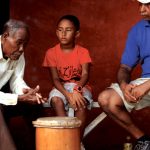Making of Barí (drum)
Aside from the Maskarada, Bonaire is known for playing the barí during the year-end period. Barí (barrel)) is a musical instrument (drum), music genre and dance form. In all neighborhoods, with the exception of Playa, the barí was played. In Rincon, Nort di Saliña, Antriòl and Nikiboko as well as in Tera Kòrá, there were special places where these parties were organized, far from the sight of the police authorities and the priest. The music of the barí could already be heard from October, to grow to a high point in the end of the year period. Especially on the eve of Christmas, and on New Year's Eve, the music of barí could be heard the most. The place that was definitely considered the center for playing barí, used to be Piedra Pretu, near the place where the Evangelical Church (Evangelical alliance) was later built.
It was at Piedra Pretu that residents of Rincon, both men and women, gathered to make music, sing and dance. Others stood in the dark at a distance to watch this popular event, fearing their presence could damage their reputation in society. The priests regarded playing the barí as diabolical, and found it in no way acceptable in their parish. Originally, apart from the barí (the barrel as a musical instrument) itself, other musical instruments as wiri, triangle and chapi (hoe) were used.
Later, other musical instruments were added. The barí (the barrel) itself came from abroad, it contained certain products. Tanned sheep leather was stretched on the barrel, this was better than the goat leather. Sheep leather is more flexible. The leather was processed with the pulp of the watapana fruit, then the roots of the pal'i kui and nails were used to attach the leather to the barí. Having a dig at people was one of the basic elements during the party of the barí. For example, if a young woman, especially if she was from a good background, became pregnant, it was sung about while playing the barí. In addition to playing the barí, people also drummed with their hands on a table. Instead of using the barí to make music, the table was used. It was just a way to prevent the police from acting. Playing the barí was forbidden, but not drumming on a table! The drumming on a table is also called "the dance of the young ladies" because civilized people, including the decent young women, could go to it without damaging their reputation. In the Mexico neighborhood, east of Antriòl, they played a lot on tables, in order to give a more civilized and legally accepted character to this activity.

